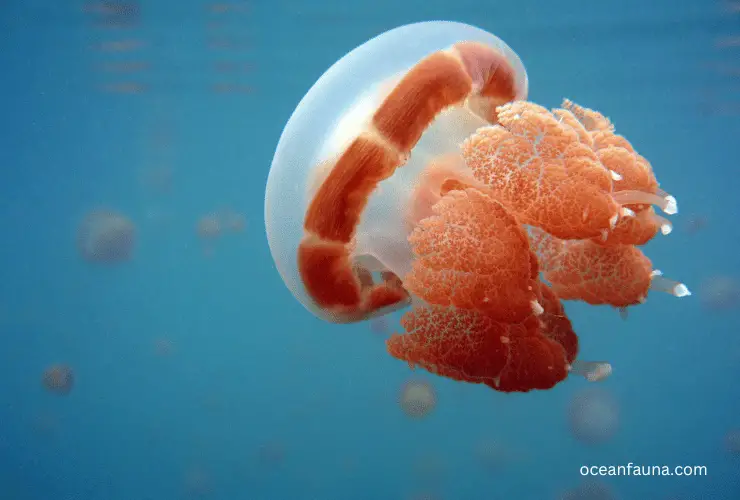The cauliflower jellyfish is one of the rarest but most beautiful sea creatures you’ll see in the ocean. They are also known as Crown Jellyfish. The stunned color of their body and their mysterious appearance will make anyone awestruck!
This is one reason that makes people even more interested to know more about them. And if you are one of them, you’ve found the right place.
In this article, we’ll talk about the in-depth details of the Cauliflower Jellyfish. But first of all, the main question is, what makes them different from other marine animals?
The lack of information about them is a key reason that makes them special. Also, they can go to any extent to their prey. But their venom is not found as deadly for humans. In addition to that, in some regions of China and Japan, people also enjoy them as food.
After knowing these facts, we are sure that you definitely want to know more about them. So, keep on reading to learn some amazing facts about cauliflower Jellyfish.
Cauliflower Jellyfish at A Glance
Let’s see some of the important details of Cauliflower Jellyfish at a glance. This checklist will help you to know about them in a minute.
| Size | 50 to 60 Centimeters |
| Weight | 4 to 89 Ounces |
| Other Names | Crown Jellyfish, Sea Jellies, Transparent Crown Jellyfish |
| Lifespan | 3 to 6 months |
| Originated In | Red sea, Indo-Pacific Ocean |
| Color | Bluish, Purple |
| Diet | Carnivorous |
Fun Facts About the Cauliflower Jellyfish
Here you’ll find some interesting facts about Cauliflower Jellyfish. Let’s begin:
- They have no scales, blood, or gills.
- In their lifetime, they have two stages: Polyp and Medusa.
- They have a transparent jelly-type body.
- Sea turtles are threats to them.
- They go to a sleep-like state at night.
- Their conservation state is not evaluated yet.
- They can be found in Indo-Pacific and Eastern Atlantic.
- The bell-shaped part of their body is used as a propeller so that they can swim faster.
- Releasing chemicals in the water is one of their communication systems.
- Though both life stages have different names, their male and female species have no specific names.
- Plankton, shrimp, and other tiny carnivorous are their food.
- Despite having no gills or scales, they can swim really fast.
- Their adaptability is really good in freezing temperatures.
- Have no cardiovascular system.
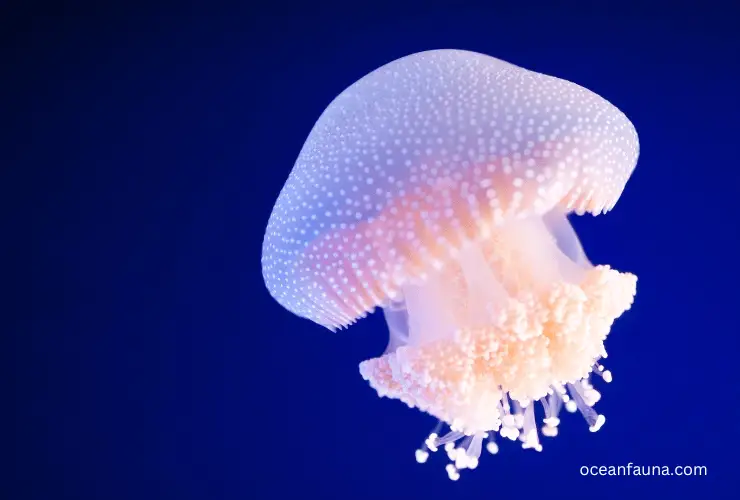
In-Depth Details About Cauliflower Jellyfish
After knowing the fun facts about these jellyfish, it’s time to go deeper. Here we’ll break down every detail of cauliflower jellyfish. So, let’s get started.
What’s The Taxonomy Of Cauliflower Jellyfish?
Jellyfish are not very common species like other marine animals. You’ll find hardly 200 species of them. Among the other species of jellyfish, Cauliflower Jellyfish are one of the rarest ones.
They are found in the deep ocean during the day and swim on the surface at night. These jellyfish belong to the Animalia kingdom.
To make the taxonomy even better, the chart is given below.
| Kingdom | Animalia |
| Phylum | Cnidaria |
| Class | Scyphozoa |
| Order | Coronatae |
| Family | Cephidae |
| Species | Cephea Cephea |
Where Do These Jellyfish Found the Most?
Cauliflower Jellyfish is scientifically known as Cephea Cephea and regionally known as crown jellyfish due to its unique structure. Among the other jellyfish, these are one of the least known categories.
Researchers couldn’t explore these jellyfish to the core though they had been discovered in 1775 by a Swedish man commonly known as Peter Froskaol.
Basically, you’ll find them in the tropical water of the western Indo-pacific to Northern Australia. To be specific, mostly found in the Red Sea, Eastern Atlantic. Moreover, they live in the pelagic zone of tropical and subtropical water.
What’s The Reason Behind Naming Cauliflower Jellyfish?
The cauliflower jellyfish is a species of large water jellyfish native to the oceans of the Indo-Pacific and Atlantic regions of the Old World.
From their appearance, you can see that they have a massive bell. The bell has a shape like an umbrella with a wide circumference. This also resembles the hood of a cauliflower.
Also Read: Sea Butterfly: Everything You Need to Know
However, what fascinates people the most about these jellyfish is the wide range of beautiful color that comes from their body. For example, the bell has beautiful pastel color. The hue of the bell can range from a pale mauve to a blushing purple.
The arms or extended stings of these jellyfish are tentacles. They use them to catch their prey.
The jellyfish’s bell contains stinging cells known as nematocysts, which shoot outward in the form of several wart-like filaments. Cauliflower jellyfish use these filaments to kill the jellyfish’s food.
Are They Available Around the Globe?
It has not been determined how many cauliflower jellyfish there are in the world’s oceans. The range of these marine organisms is quite broad. Moreover, researchers assumed that the population size remains stable across the entirety of that range.
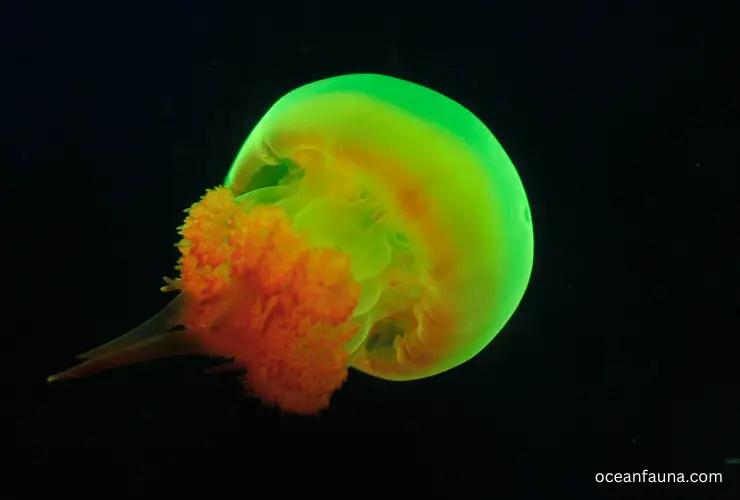
The population of cauliflower jellyfish is in danger due to fisheries that specifically target jellyfish. However, there have been no reports of major damage. They are also the primary food source for marine turtles.
Anatomy Of Cauliflower Jellyfish
The anatomy of cauliflower jellyfish is very simple. Basic anatomy is divided into two cell layers: the epidermis (external layer) and the gastrodermis (internal layer).
The gastrodermis of the cauliflower jellyfish is the opening of guts and reproductive cells. As jellyfish have no other organ, this layer helps them to take all the nutrients and oxygen through their cells.
On the other hand, the outer cell or the epidermis consists of the nervous system. It is also known as a nerve net.
Though these are the major cells of cauliflower jellyfish, there is another cell in between them: the mesoglea. This layer of the jellyfish contains most of the body.
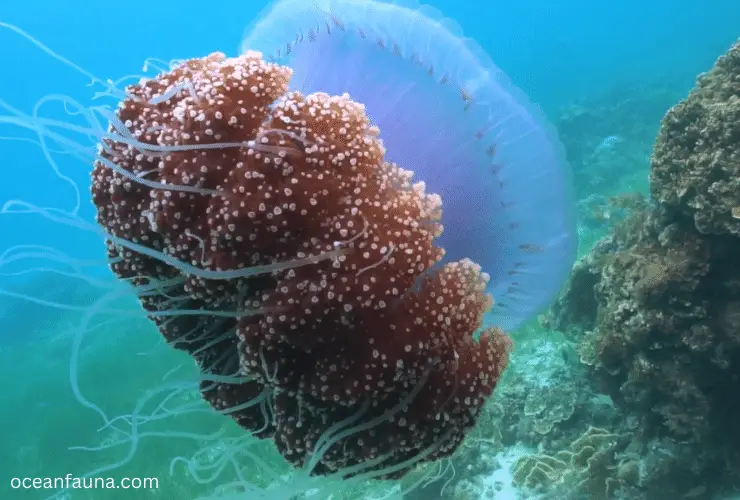
Now let’s get into the breakdown of the anatomy of the cauliflower jellyfish. The main body consists of a bell-shaped hood that protects the internal structure.
In the internal structure of the cauliflower jellyfish, there are tentacles (the colorful string that comes from the system). These tentacles are used to catch prey for them.
That’s why a venomous cell called ‘cnidocytes’ cover the tentacles of the cauliflower jellyfish. As a result, it helps them to kill other animals.
How Do Cauliflower Jellyfish Reproduce? [Reproduction System of Two Stages]
Cauliflower Jellyfish have a complex reproduction system. In their lifetime, one jellyfish reproduces both sexually and asexually, which means they form their body differently according to its requirements.
To be specific, the adult cauliflower jellyfish is called a medusa. They reproduce sexually, meaning the massive release of eggs and sperm in the open ocean. You’ll be surprised to know that sometimes the whole population of medusa reproduces at the same time. Isn’t that interesting?
So far, it’s clear that their fertilization takes place in the water. Following fertilization, the eggs become free-swimming larvae. It looks like a mini flattened pear or more like a miniature pear. And after a few days, the eggs swim away from the parent creatures, attach to the firm surface, and then transform into an individual creature.
Another stage of the cauliflower jellyfish is polyps. In this stage, the jellyfish reproduce asexually. Basically, polyps create a genetically identical polyps. This happens in the early life stage of the cauliflower jellyfish. However, if they don’t transform into a medusa, they can reproduce in this way till death.
To conclude, cauliflower jellyfishes are very short-lived. They can live for a maximum of 6 months. And in this lifespan, they transform their body into Polyps and Medusa. Lastly, the reproduction system depends on that particular stage.
How Do They Digest Food? [Digestive System of Cauliflower Jellyfish]
As previously said, jellyfish lack the intestines, liver, and pancreas in most other animals’ digestive systems. Without these organs, cauliflower jellyfish are unable to digest food as efficiently as other animals. Due to the absence of these organs, a single opening is responsible for both the ingestion of food and the expulsion of waste.
The trash that cauliflower jellyfish produce is expelled from their bodies very rapidly. Jellyfish cannot afford to carry around an excessive amount of weight with them since doing so would make it difficult for them to maintain their stability.
What’s The Size and Weight of Cauliflower Jellyfish?
These bluish-purple sea creatures are found in East Atlantic and Indo-Pacific regions. Compared to other jellyfish, these are quite large in size. They usually get 50 to 60 centimeters.
However, the bells of cauliflower jellyfish are generally 7.8 inches tall and 6.7 inches wide and have eight arms or tentacles that help them to catch their desired prey.
The length of a cauliflower jellyfish is between 13 and 30 centimeters, with a bell width of 9.84 to 23.62 inches (25 to 60 centimeters) and a bell height of 8.7 to 19.7 inches (22 to 50 centimeters) (33-78 cm). Cauliflower Jellyfish typically live for three to six months and weigh between.04 and.89 ounces (.02-.4 kg).
Cauliflower Jellyfish’s Habitat
Cauliflower jellyfish are deep-water creatures. That means you won’t find them on the sea surface. They live at a deep height under the sea level.
Besides, their living height varies because they love to stay at different heights. However, they are mostly seen in the paleic zone of the ocean. Their water height of them ranges between 9842ft or 3000m. It indicates that they are deep sea creatures.
Also Read: Red Lionfish: Habitat, Diet, Anatomy & Fun Facts
In addition to that, their adapting capability in freezing temperatures is amazing. They can dive deep into the ocean during the day and move to shallow water at night. Also, they can be found in ocean bays and estuaries.
Do They Have Any Conservation Status?
It has not been determined whether or not the cauliflower or crown jellyfish should be considered endangered. Due to the resilient character of these jellyfish, they are the species of wild jellyfish that generate the least amount of concern.
The jellyfish fishing businesses will not significantly impact their population sizes, and they are easily observable across their whole range, including the Indo-Pacific Ocean and the East Atlantic Ocean.
Are Cauliflower Jellyfish Venomous?
Yes. They are one of the deadliest jellyfish found in the ocean. Although they are venomous to their prey, they are not harmful to humans. Stings of a cauliflower jellyfish release venom to kill their prey.
Though they stay in the deep ocean, they’ll inject anything that comes into their contact. However, their venom won’t hurt humans, but it’s better to be on the safer side. Also, remember to take proper protection if you ever need to touch them.
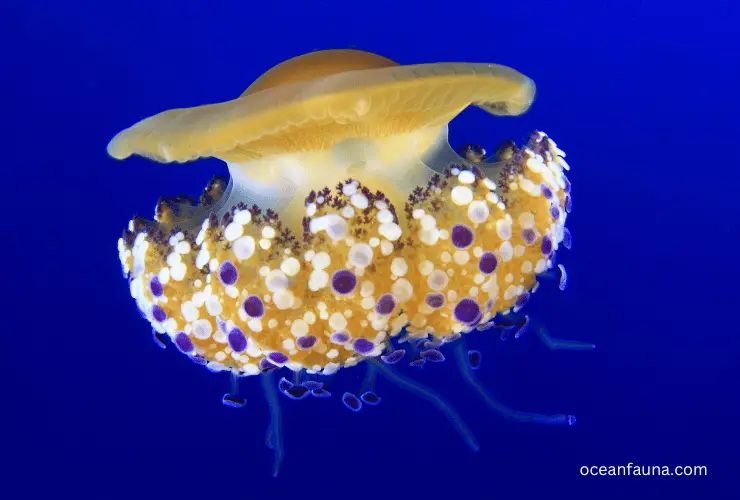
However, a common misconception about them is they intentionally inject poison into other creatures. That’s not true. If they feel any danger, they attack. Otherwise, they are very quiet by nature.
What do These Jellyfish Eat for a living?
By observing their size, it’s easy to say that cauliflower jellyfish live on tiny sea creatures. The main food of these jellyfish is zoo plankton, but they can eat almost anything they float into.
They are venomous jellyfish and can be dangerous to their prey and sting them from behind. By nature, cauliflower jellyfish are carnivorous (feed or eat other animals), feeding on things like plankton, shrimp, fish eggs, algae, and the larvae of other invertebrates.
Who Do Cauliflower Jellyfish Live With?
Though most of the jellyfish live alone, these cauliflower jellyfish are sometimes found in groups. Scientists have named these groups bloom.
Thousands of jellyfish can create a bloom together. In that case, other tiny marine fishes got attracted by the colorful bloom, and that’s when cauliflower jellyfish attack their prey.
Do Cauliflower Jellyfish Have Scales?
Though there are fish in their name, they are not real fish. And like other sea creatures, they have no scale in their body. That’s why there’s always a debate on their swimming process.
They are basically invertebrates from the phylum group cnidaria. That indicates cauliflower jellyfish won’t have any scales, gills, or fins.
Without the spine, swimming is quite difficult, right? But cauliflower jellyfish use their bells or the umbrella-shaped part of their body for swimming. This bell helps create a wall of water and then pushes it off so they can swim quickly.
Even though they still don’t have all the parts for swimming, these cauliflower jellyfish are one of the quickest swimmers. That helps them to survive in the deep ocean.
Do Cauliflower Jellyfish Have Any Organs?
From their appearances, it’s pretty clear that there is no spine in the cauliflower jellyfish. Rather than the spine, they have solid jelly-like gelatinous stuffing.
Apart from this, you’ll be surprised to know that they do have small organs called rhopalia situated between the scalloped edges. These organs are the sensory system of cauliflower jellyfish.
Moreover, there is a pacemaker next to each rhopalia. These pacemakers process all the sensory data and regulate the cauliflower jellyfish’s pulse rate. Another important characteristic of these pacemakers is that they can detect any dangers around the jellyfish, so they’ll react immediately if they feel anything wrong.
What Is Their Body Made Of?
As previously said, cauliflower jellyfish have a jelly-like transparent body. On top of that, they have no brains, hearts, or scales, which makes their body even thinner.
So, the question is, what is their body made of? Their body contains 95% of water. Additionally, after washing up on shore, their bodies may evaporate into thin air within a matter of hours.
Do Cauliflower Jellyfish Have Brains?
No wonder cauliflower jellyfish is a unique and mysterious creature. What makes them even more perplexing is their completely different physical properties.
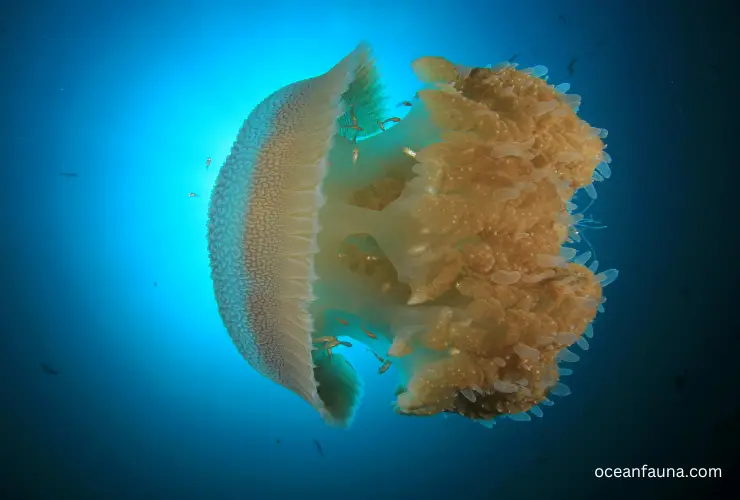
And one of the important facts is that they have no brains. Instead of brains, they have a nerve net or a network of neurons. Basically, the nervous system is divided into small sensors that help them to survive, eat, and sleep.
With the help of the nervous system, they are able to sense the environment around them.
A special structure covers the nerve net, which is statocysts. This structure is also known as a balance sensor. As they have no brains, this balance sensor lets them know whether they are facing up or down.
There is another sensing organ called ocelli to sense the presence or absence of light.
How Do Cauliflower Jellyfish Sleep?
Among other jellyfish, cauliflower jellyfish is one of the species that can go into a sleep-like state without having a central sensory system. Now the question is how?
Researchers found that most categories of jellyfish, including cauliflower jellyfish, have less pulse rate during the night compared to the daytime. During the day, they’ll pulse and swim quickly. But on the other hand, at night, the pulse rate will get slower. Also, they respond less to any kind of disturbance at night.
However, the fascinating fact about their sleep is that if they are kept awake in the night for any reason, they’ll be tired the following day.
Can You Keep Them in Aquariums?
These jellyfish got popular due to the colors that come from their body. That’s why people want to keep them in an aquarium. Keeping them in an aquarium isn’t difficult because they don’t require much maintenance.
Conclusion
Till now, you got a detailed idea about cauliflower jellyfish. Though they are rare, scientists successfully discover most of their lifestyles. But there is yet to discover!
This jellyfish has a wonderful bluish-purple hue and is covered in bumps and lumps, making it look like a bluish cauliflower floating aimlessly in the ocean. Interestingly, they flash their lights at potential enemies when they feel threatened.
However, if you have read so far, you are already amazed by their huge diversity. Even after that, if you have any questions regarding cauliflower jellyfish, you can post them in the comment box. Thank you!

